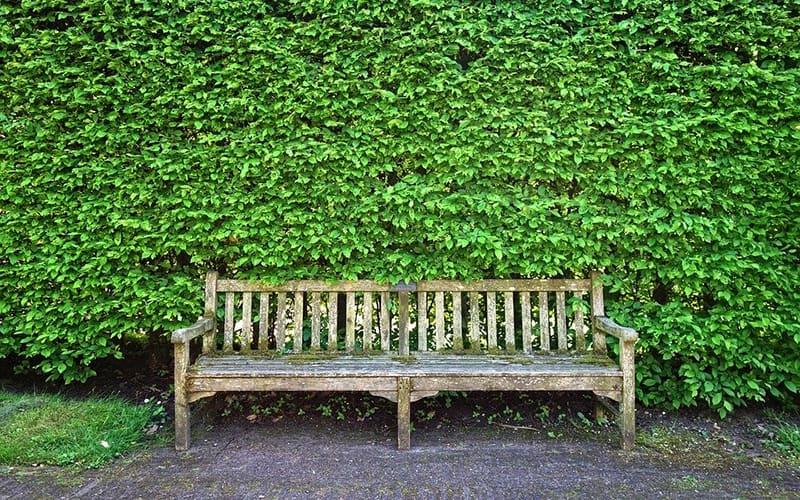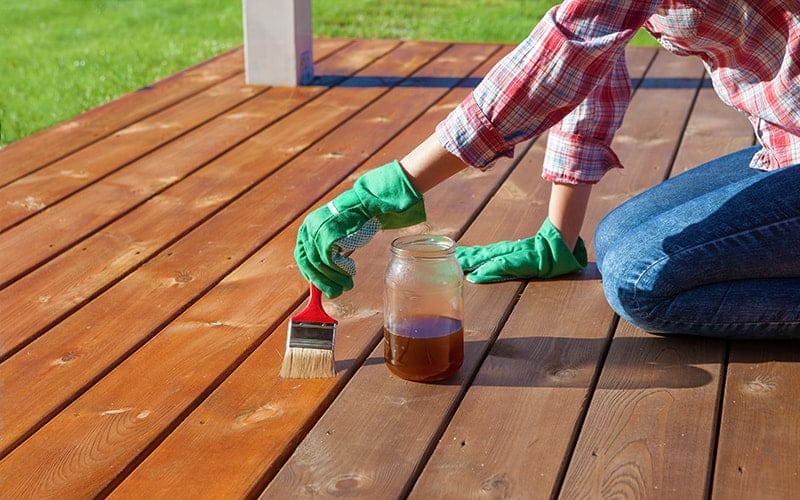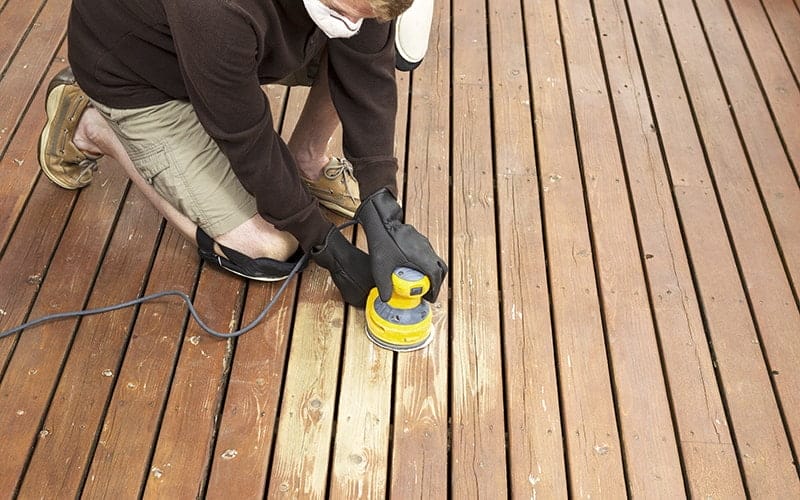Wood and water can often mix well, think boats, floating docks, and even beautiful driftwood but, prolonged contact with water is going to have negative effects unless the wood is protected. When there is no protection, wood can rot and fall apart, warp and change shape, or become stained and ugly. No matter which of those happen, the wood is going to lose structural integrity.
Indoors or out, it is beneficial to protect any wood that is subjected to the elements, foot traffic, or heavy use. Waterproofing wood is easy and will protect your wood for years, and we’ll show you just how to do that.
You are watching: How to Waterproof Wood for Outdoor Use?
In This Article
- Why Waterproof Wood?
- Types of Waterproofing
- How to Waterproof Wood
- Most Durable Wood For Outdoor Use
- DIY Wood Waterproofing Videos
Why Waterproof Wood?
Many things that can damage wood. One of the most common is moisture, but wood can also be attacked by UV light, extreme temperatures, insects, and more.

Waterproofing will take care of many of those problems and lengthen the life of the wood.
Waterproofing is also a chance to change the way that your wood looks and add some color and beauty to it. When you are waterproofing something like a deck or patio, you can protect it while adding some color too.
Waterproofing will help to protect against:
- Cracking, warping, and splitting.
- Stains, discoloration, wear & tear, and wood breakdown.
- Scratches and scuffs from heavy foot traffic.
- Mold, mildew, and any other organic growth.
Types of Waterproofing
When it comes to waterproofing your wood, there are two main routes that you can take: staining or sealing.
Sealers are generally clear, showcasing the natural beauty of the wood, and form a protective layer on the outside of the wood to prevent moisture from getting in.
Stains absorb deeper into the wood, protecting it, and adding a stain to the wood, contributing to the natural beauty or covering the wood completely.

Oil vs. Water: oil-based waterproofers last longer and penetrate the wood more deeply, but water-based waterproofers can be applied in damp conditions and are easier to clean.
Clear vs. Tinted: clear waterproofers showcase the natural grain of the wood and generally help to prevent fading, while tinted waterproofers offer better UV protection and enhance the look of the wood, often allowing the grain to show through. Clear waterproofers should be reapplied every year or two, and tinted waterproofers can be reapplied every two or three years.
How to Waterproof Wood
Waterproofing wood is easy to do, but care should still be taken to ensure that you waterproof thoroughly. Done correctly, waterproofing will keep out water for years. Apply waterproofing once, and then reapply every few years to maintain it.
Here’s an easy step-by-step:
1. Clean: The stain or sealant is not going to cling to the wood is there is a surface layer of dirt and grime. Sweep the wood first to remove large and loose debris, and then use a general cleaner to remove the last of the grime. Of course, if you are applying to new wood, then skip this step.
Read more : How to clean polywood furniture – outdoor experts explain what and what not to do
2. Sand: A smoother surface is going to be adhered to more easily. Once the wood is clean, sand with some rough sandpaper first before finishing with smooth sandpaper. Wipe down the surface when you are done to remove the particles of sanded wood.

3. Stain or Sealant: Do you want to add color or let the natural grain shine? Check what the different sealants and stains can do for the wood and choose the one that makes the most sense.
4. Apply: Use your brush or sprayer to apply the first coat to the wood. Let the stain or sealer dry for the appropriate time, as per the instructions of the product.
5. Sand: After applying the first coat and letting it dry, you need to sand down the surface before you apply the next coat. Use fine sandpaper to sand the wood, and a dry cloth to wipe away the small particles.
6. Apply (again): Once you have sanded, you can apply the next coat. Add another layer of stain or sealant and let it dry. If needed, repeat the sand and apply steps to build up the necessary coats.
7. Cure: The wood needs to cure before use. Leave the wood unladen for three days before walking on it or placing any furniture on top.
Pro tip: Don’t forget your protective equipment. We recommend eyewear, gloves, and something to cover your clothing.
Related: The 9 Most Durable and Comfortable Work Pants For Men
Most Durable Wood For Outdoor Use
There are many durable kinds of wood out there, here are some of the best:
Acacia
There is an abundance of Acacia in the world and, in some places, it is even considered an invasive species. With so much of the wood, it makes it an eco-friendly and sustainable choice.
Acacia wood is a dense hardwood that can stand up to the elements. The durable wood is often used in boat building, so is a perfect choice for decks and other outdoor furniture.
The wood has a rich, brown color and can survive outside without finishing, though a stain or sealant will add extra protection and prolong its life.
Cedar
Cedarwood has been long used outdoors. Many fences, decks, and other outdoor furniture is crafted from cedar. The natural resin in cedar makes it resistant to insects and rot. Cedar is a great choice for any wood that is going to be in contact with the ground.
Cedar is also a versatile wood that is light in color and can be finished to match your home or yard structures. You can add a stain of almost any color to the cedarwood, and still allow the grain to show through. If left in its natural state, the wood will turn a silvery grey color, maintaining an elegance that many people prefer.
Read more : 7 Best Porch Ceiling Ideas
The wood is softer than others, so can scratch more easily, but its natural resistance to moisture makes it less likely to crack or split.
Cypress
Cypress is also naturally resistant to insects and rot, making it a fantastic wood for the great outdoors. Like cedar, you can leave it unfinished to showcase the natural grain and take advantage of the natural water-resistant properties of the wood, but a stainer or sealant will prolong the life of the wood.
Cypress also turns and elegant silvery-grey over time, if left unfinished, and it does not shrink or swell much as the seasons change. Cypress is an excellent choice for outdoor furniture and structures but is not as abundant as cedar.
Eucalyptus
Another sustainable wood that grows quickly and has a plentiful supply. It is another popular choice for outdoor furniture and is both high-quality and durable.
Eucalyptus has an elegant grain that many people make the focal point of their furniture or fence, but it is also strong, durable, and has a smooth finish. The high oil content makes it resistant to rot and decay. Staining will increase longevity and also help to maintain the richness of the wood’s tone.
Redwood
Redwood is a beautiful wood but is not as sustainable as the other choices on our list. Redwood trees grow slowly, so the supply is not plentiful, though more trees are being planted, and that is starting to change.
It is another durable wood that has a natural resistance to insects and rot, and it does not shrink or swell as the seasons change. It is a softer wood, much like cedar, so it can become easily scratched and dented.
One of the main reasons for using this wood is the natural beauty of the grain and the rich, red-brown color. Some sealers will showcase the amazing beauty of the wood and will seal in the color that can rub off if left unsealed, getting onto clothing and other items.
Teak
Teak is a hardwood and perfect for outdoor furniture. It can be one of the hardest, strongest, and most durable types of wood out there.
A staple in boat and shipbuilding for years, patio furniture made from teak can withstand almost any weather condition and all uses. The natural oils in the wood help to make it resistant to rot, decay, and insects.
It is a low-maintenance wood and can be left unsealed, taking on a greyish tint over time.
Robinia
A wood that is not as well known as teak, but one that shares many of the same attributes. It is a hardwood, perfect for outdoor furniture, but it will also take on paint, where teak will not.
You can paint this wood any color, matching it with your home, or making it a focal point in your yard. A durable wood that can be finished in multiple ways.
DIY Wood Waterproofing Videos
Here are some of the best videos that I could find for common DIY wood waterproofing projects.
Waterproofing a Wooden Deck
Waterproofing a Wooden Table
Waterproofing a Wooden Planter
Waterproofing a Wooden Floor
Source: https://gardencourte.com
Categories: Outdoor


